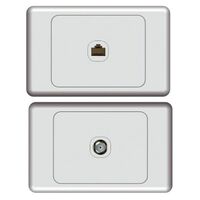Kingsgrove Branch:
RJ45 Wall Plate

G'day! Let's talk about that battle we all have. You're trying to stream the footy in 4K, or you're on a massive Zoom call for work, and the bloody Wi-Fi starts dropping out. It's buffering, it's lagging, and it's a fair dinkum nightmare.
Wi-Fi is ripper for wandering around with your phone, but for your serious gear—your smart TV, your gaming console, or your home office PC—you just can't beat a rock-solid, hardwired connection. And that, mate, all starts with a proper RJ45 wall plate.
So, What is an RJ45 Wall Plate, Exactly?
An RJ45 wall plate is the 'socket' side of your internet connection. It's the female port on the wall that you plug your Ethernet (RJ45) cable into.
In Aussie tradie lingo, the actual socket part is called a 'mech' (mechanism) or a 'jack'. This little RJ45 jack then clips into a standard Aussie wall plate, often right next to your power points (GPOs).
Its one and only job is to be the neat, tidy, and professional termination point for the data cable that's running through your walls, connecting your room directly back to your NBN modem or network switch.
The Ripper Benefits: Why a Hardwired Point Beats Wi-Fi
In a country full of double-brick homes that are proper Wi-Fi killers, a hardwired RJ45 wall plate is a game-changer.
- Blazing Fast Speeds: You'll almost always get a faster, more consistent speed than on Wi-Fi. Perfect for 4K streaming or downloading big files.
- Rock-Solid Reliability: No more random dropouts. A physical cable connection doesn't care if your neighbour fires up their microwave or if you've got thick brick walls.
- Lower Latency (Ping): This is the big one for gamers. A wired connection gives you a much lower, more stable ping for a lag-free experience. You can't blame the connection when you miss that shot!
- It Just Looks Schmick: It's the proper, professional finish. No more daggy cables stapled around the skirting boards.
The CRITICAL Safety & Compliance Warning: This is NOT a DIY Job, Mate!
Righto, let's get dead serious for a sec, because this is the most important part of the whole article.
- DIY: Buying a pre-made Ethernet cable (a 'patch lead') to run outside your walls from the RJ45 wall plate to your computer? Go for your life, mate. Too easy.
- PRO ONLY: Want to install a new data point? This involves running a new data cable inside your walls, floor, or ceiling and terminating it at a new RJ45 wall plate.
In Australia, this is strictly not a DIY job. Any fixed data, communications, or telephone cabling must be installed by a licensed cabler (registered with ACMA).
Why? It's the law, mate. A dodgy data install (especially with cheap parts from a non-specialist supplier) can create interference (messing up your and your neighbour's NBN). Worse, if it's run too close to 240V power wiring without proper separation, it can become a serious electrical hazard. Don't be a galah.
A Professional Job Needs Professional Gear
A licensed cabler or licensed electrician knows that a rock-solid, high-speed network relies on high-quality, compliant components from end to end. They can't risk a job on a cheap, dodgy RJ45 wall plate that will fail in a year or, worse, isn't even rated for Cat6 speeds.
This is why they source their gear from a trusted electrical wholesaler. As one of Australia's most comprehensive electrical wholesaler and supplier networks, Schnap Electric Products stocks the lot for the professional installer. They've got a massive range of high-quality, professional-grade data gear, including RJ45 wall plate mechanisms ('mechs'), stylish faceplates (like the Clipsal Iconic range), Cat6 data cable, and all the specialist crimping and testing tools that a qualified professional needs to do the job right. For a connection that won't let you down, the pros start with quality gear from a supplier like Schnap Electric.
Recent posts

Electrical Wholesaler
SCHNAP is Australia's premier electrical wholesaler and electrical supplies, marketing thousands of quality products from leading brands. Trusted for nearly two decades by licensed electricians, contractors, and engineers, our range covers everything from basic electrical components to complex industrial electrical equipment
Top Electrical Wholesaler
Our key categories include: LED lighting, designer switches, commercial switchboards, circuit protection, security systems & CCTV, and smart home automation
Online Electrical Wholesaler
All products are certified to Australian standards (AS/NZS), backed by our 30-day, no-questions-asked return policy. Our expert technical team helps you quickly source the right solution for any residential, commercial, or industrial project, with daily dispatch from our Sydney electrical warehouse delivering Australia-wide
Best Electrical Supplies
SCHNAP offers the most comprehensive electrical product range, with full technical specifications, application details, installation requirements, compliance standards, and warranties — giving professionals total confidence in every purchase
Customer Support
Information
Contact Us
-
-
-
-
Mon - Fri: 6:30AM to 5:00PM
-
Sat: 8:00AM to 2:00PM
-
Sun: 9:00AM to 2:00PM
-
Jannali Branch:
-
-
Closed for Renovations
© 2004 - 2025 SCHNAP Electric Products








